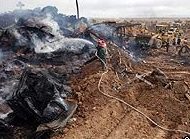During the middle of the night on February 18, 51 railway cars carrying highly flammable materials — sulfur, fertilizer, petroleum, and cotton — broke free from their siding at the Abu Muslim station. They rolled down the track for about 20 kilometers, eventually derailing and dropping down an embankment into the village of Khayyam, near Nishapur. Although the train was unmanned, rescue workers began searching for anyone who might have been trapped inside, and to extinguish fires that were erupting in and around the wreckage. A large crowd of local people collected to watch the operations.
The substances in the cars had leaked following the crash. With the rescue workers and crowd in close proximity, the cargo exploded, with a force estimated to be the equivalent of about 180 tons of TNT. The entire village was demolished and all workers and onlookers were killed or seriously injured. The train and village continued to burn and explode over the following several days.
Although the total death toll is not known, authorities were able to identify 295 confirmed killed and over 460 injured, including 182 rescue workers and state officials.











